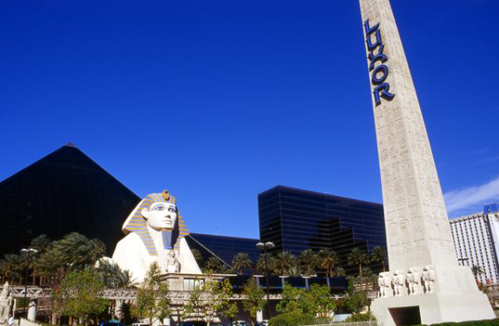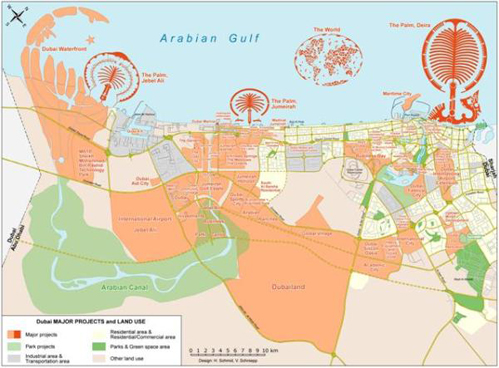Forschungsprojekt
Ökonomie der Faszination – Las Vegas und Dubai als Beispiele thematisch inszenierter Stadtlandschaften
Hohe Investitionen im Immobilien- und Tourismussektor sowie stark ansteigende Tourismus- und Zuwanderungszahlen haben in Dubai und Las Vegas zu einem anhaltenden Wirtschaftsboom geführt. Gleichzeitig ist vor dem Hintergrund einer Urban Governance und der Übertragung von Kompetenzen an private und semi-staatliche Akteure in beiden Metropolen ein rascher Stadtumbau mit unzähligen Erlebnis-, Einkaufs- und Kunstwelten initiiert worden. Eine Entwicklung, die durch eine weitgehende Inszenierung der Lebenswelt und vor allem eine Ökonomie der Faszination
geprägt ist: Kasino- und Hotellandschaften, die verschiedene Schauplätze vom antiken Rom bis zum heutigen New York simulieren, künstliche Inseln in Gestalt von Palmen oder ganzen Weltkarten sowie weitere Superlative in Form von thematisch inszenierten Einkaufszentren und Sportarenen sind die augenscheinlichsten Folgen dieser rasanten Entwicklung. Dubai und Las Vegas sind damit nicht nur Vorreiter einer allgemeinen Kommerzialisierung und Erlebnisorientierung im Zeitalter wirtschaftlicher und kultureller Globalisierung, sondern auch Extrembeispiele einer postmodernen Stadtentwicklung.

Im Forschungsprojekt werden anhand der beiden Beispiele Dubai und Las Vegas Leitlinien für eine Forschungsperspektive Ökonomie der Faszination
entwickelt. Für ein analytisches Verständnis sind zunächst allgemeine Trends und Entwicklungslinien vor dem Hintergrund von Urban Governance, Erlebnisorientierung und Kommerzialisierung wesentlich. Sie ergeben den Ausgangspunkt für eine Analyse der Wirkungsmechanismen von Aufmerksamkeit
und Faszination
, die als wesentliche Aspekte einer Ökonomie der Faszination
gesehen werden. Für ein Verständnis dieser Mechanismen sind die wirtschaftlichen Zusammenhänge, Akteure und Handlungsprozesse von besonderer Bedeutung. In Anlehnung an Giddens’ Strukturationstheorie (1984) und Benno Werlens Sozialgeographie alltäglicher Regionalisierungen
(1995, 1997) bietet sich deshalb eine handlungstheoretische Grundperspektive an. Gleichzeitig werden jedoch die ökonomisch orientierten Bemühungen um Aufmerksamkeit über eine postmoderne Ästhetik und symbolische Aufladungen umgesetzt. Die Ausformulierung einer Ökonomie der Faszination
als Forschungsperspektive erfordert deshalb neben der handlungstheoretischen Grundperspektive eine Erweiterung um semiotische Ansätze.

English Summary
Large investments in the real estate and tourism sector, as well as rising numbers of tourists and immigrants, have led to a sustained boom in Dubai and Las Vegas. At the same time, and against the background of an urban governance and the transfer of competences to private and semi-state actors in both metropolises, a brisk urban transformation has been embarked upon, with the creation of countless entertainment, shopping, and artificial worlds. This development is primarily characterised by the theming of everyday life, but above all an Economy of Fascination
. The casino and hotel landscapes simulating various scenes from Ancient Rome to modern New York, artificial islands in the shapes of palm trees or whole world maps as well as other superlatives in the form of themed shopping malls and sports arenas are the most visible results of these rapid changes. Dubai and Las Vegas are not only the first in a general trend towards commercialisation and entertainment orientation in the age of economic and cultural globalisation but they are also quite extreme examples of post-modern urban development.
This project develops guidelines for a research perspective called „Economy of Fascination“ and turns to Dubai and Las Vegas to exemplify the approach. An analytical understanding first builds on general trends and development lines against the backdrop of urban governance, entertainment orientation, and commercialisation. They form the starting point for an analysis of the mechanisms of attention
and fascination
, which are considered to be the main aspects of an Economy of Fascination
. In order to understand these mechanisms the economic interrelations, protagonists, and processes of action are of particular importance. Following the theory of structuration
by Anthony Giddens (1984) and the social geography of everyday regionalisations
by Benno Werlen (1995, 1997), an action theory approach lends itself as a basic perspective. At the same time though, the economically-oriented attempts to gain attention are put into practice using post-modern aesthetics and symbolic ascriptions. Formulating an Economy of Fascination
as a research perspective thus calls for an extension of the action theory to include semiotic approaches.

